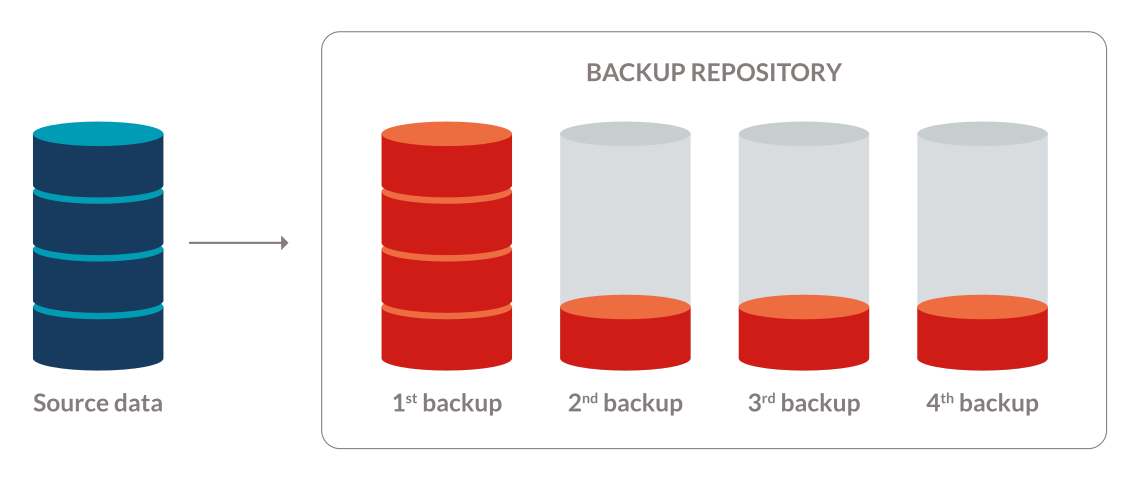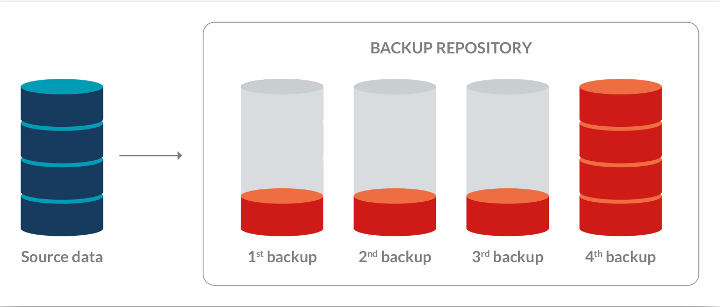Minarca, the centralized data backup management software developed by IKUS, uses the features of Rdiff-backup software built on a reverse differential backup process. Rdiff-backup was chosen for the multitude of advantages it already offered, namely the fact that it can be used on multiple platforms (Linux, Unix, Windows, Mac), it can be configured from simple command lines, it has demonstrated stability and robustness, and it benefits the good of the open-source community. Reverse incremental backup is an additional advantage since it increases backup security.
Incremental backup
You may not know it, but the vast majority of data backup software uses an incremental backup process, i.e., the backup performed is based on the increment of the last backup. With each backup run, an increment based on the difference from the previous day's increment is kept. In other words, a backup of all files is executed, for instance, on the first day of the week, and each subsequent backup is only a backup of the new or modified files. When we wish to recover a complete file, the system will start from the first backup and process each backup of the week one by one to rebuild the file until it has the most recent version.
Incremental backup only saves modified data; the data that has changed since the last backup.

Benefits :
Takes up less space.
Faster than a full backup.
Disadvantage :
Not resilient in the event of corruption. If corruption occurs during the second backup, it would be impossible to restore anything afterwards without error or corruption.
This backup process is faster because it solely focuses on files that have been processed, and additionally, it takes up less storage space. However, it does have a high risk of data corruption. For example, if a file is lost due to human error, a complete file recovery will not restore the lost file (e.g. Duplicati, Acronis).
Reverse incremental backup
In the case of the Rdiff-backup software, the backup process is based on reverse incremental backup, i.e., the completed backup is created on the difference from the previous backup but starting with the last backup. Similarly to the incremental backup, an increment is kept at each backup run based on the difference from the previous day's increment. However, the increment from the previous day is added to that of the current day. Furthermore, the most recent version is immediately available. You don't have to run all the previous increments to restore the set to obtain an up-to-date backup. But should you wish to find the last version of a document, you will need to go back to an earlier point in time.
Reverse incremental backup only backs up modified data, but the last backup is a mirror of source data.

Benefits :
Takes up less space.
Resilient in the case of corruption. If corruption occurs, it will not spread to recent backups.
Faster than a full backup.
Disadvantage :
Uses a bit more CPU resources.
This reverse backup process is slightly longer if you wish to access an earlier version of your data and requires more storage space. Still, it offers a greater advantage to the usual data backup process because it is more resistant to data corruption. Indeed, for incremental backup it is necessary to ensure that each of the increments is not corrupted. If one of them were corrupted, it would then be impossible to recover the most recent version of the document. This is not the case with reverse differential backup.
By using a reverse differential backup process, the Rdiff-backup software built into Minarca ensures optimal data backup management. It secures immediate access to the latest version of backup data – because in 99.9% of cases, it's the one we want to retrieve! It also helps strengthen its robustness by reducing the risk of data loss for its users.